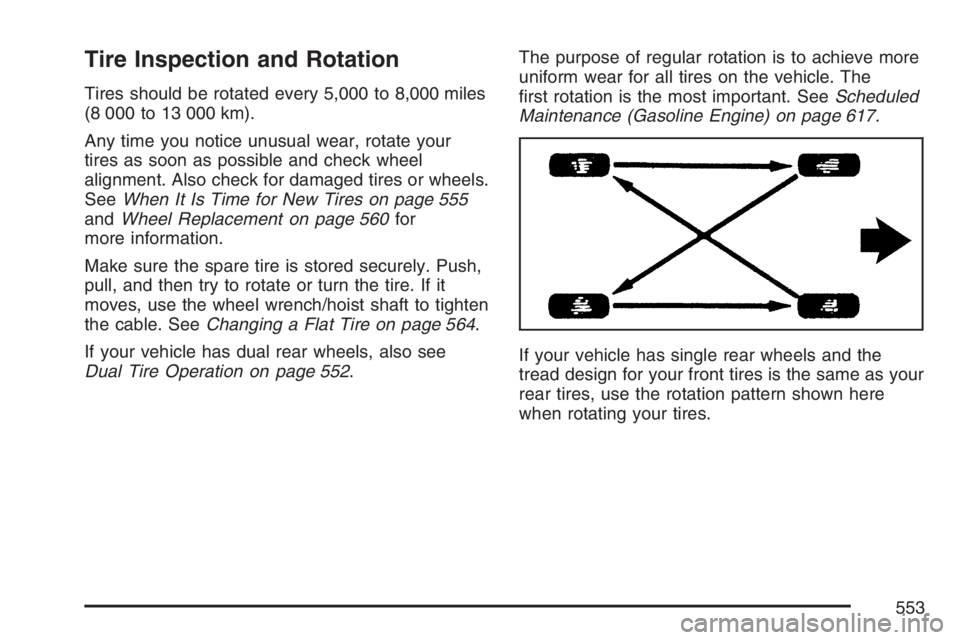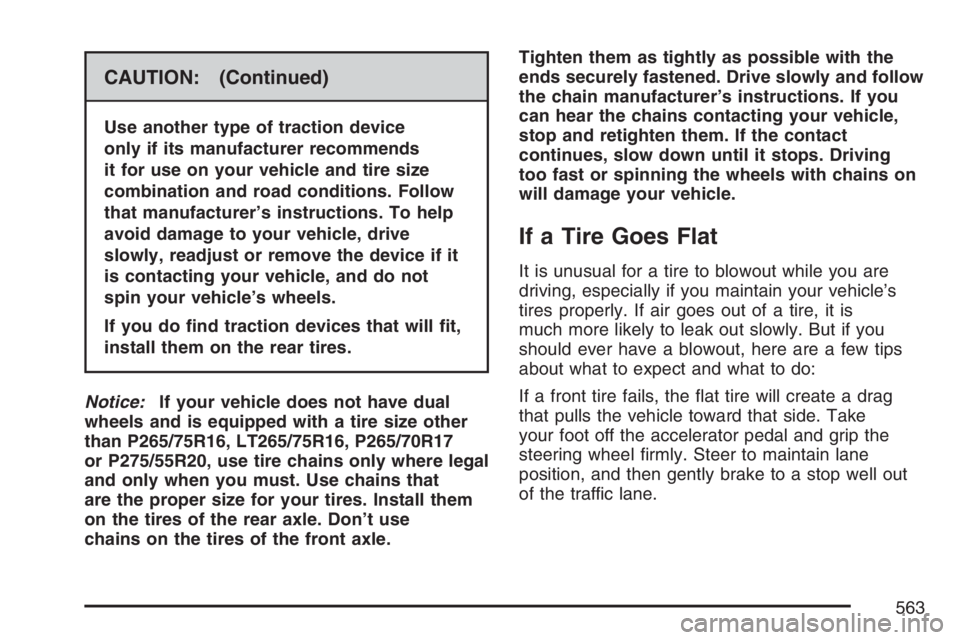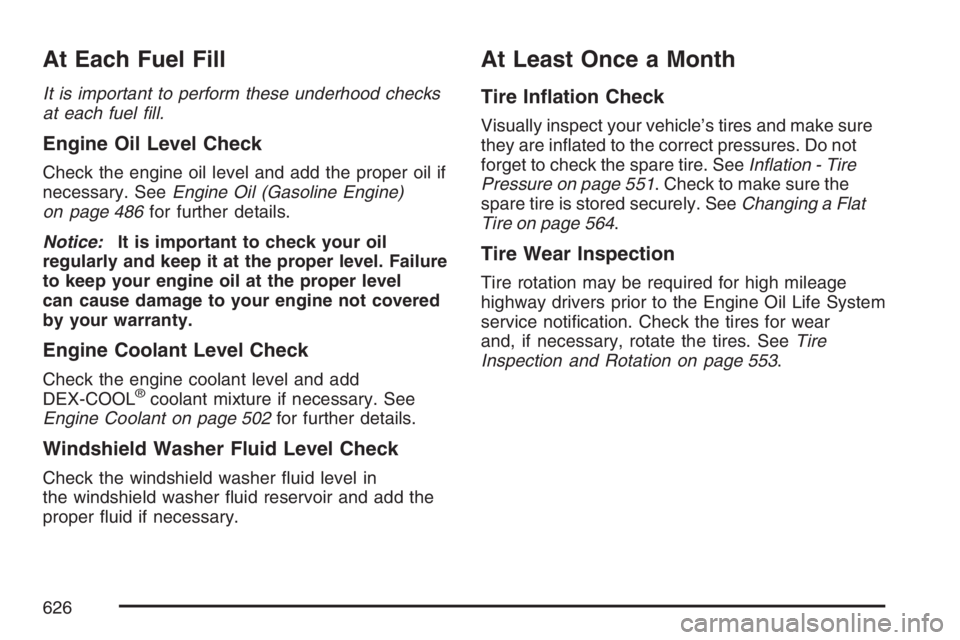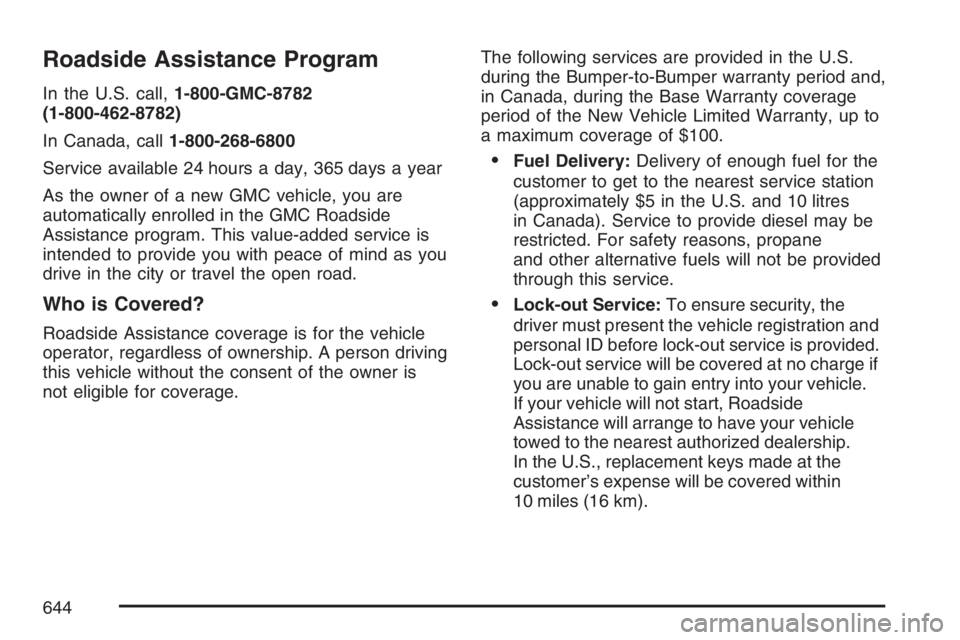Page 542 of 674
Windshield Wiper Blade
Replacement
Windshield wiper blades should be inspected for
wear and cracking. SeeScheduled Maintenance
(Gasoline Engine) on page 617for more
information.
Replacement blades come in different types and
are removed in different ways. For proper type and
length, seeNormal Maintenance Replacement
Parts (Gasoline Engines) on page 632.To replace the windshield wiper blade assembly
do the following:
1. Lift the wiper arm away from the windshield.
2. Push the release lever (B) to disengage the
hook and push the wiper arm (A) out of the
blade (C).
3. Push the new wiper blade securely on the
wiper arm until you hear the release lever
click into place.
542
Page 553 of 674

Tire Inspection and Rotation
Tires should be rotated every 5,000 to 8,000 miles
(8 000 to 13 000 km).
Any time you notice unusual wear, rotate your
tires as soon as possible and check wheel
alignment. Also check for damaged tires or wheels.
SeeWhen It Is Time for New Tires on page 555
andWheel Replacement on page 560for
more information.
Make sure the spare tire is stored securely. Push,
pull, and then try to rotate or turn the tire. If it
moves, use the wheel wrench/hoist shaft to tighten
the cable. SeeChanging a Flat Tire on page 564.
If your vehicle has dual rear wheels, also see
Dual Tire Operation on page 552.The purpose of regular rotation is to achieve more
uniform wear for all tires on the vehicle. The
�rst rotation is the most important. SeeScheduled
Maintenance (Gasoline Engine) on page 617.
If your vehicle has single rear wheels and the
tread design for your front tires is the same as your
rear tires, use the rotation pattern shown here
when rotating your tires.
553
Page 563 of 674

CAUTION: (Continued)
Use another type of traction device
only if its manufacturer recommends
it for use on your vehicle and tire size
combination and road conditions. Follow
that manufacturer’s instructions. To help
avoid damage to your vehicle, drive
slowly, readjust or remove the device if it
is contacting your vehicle, and do not
spin your vehicle’s wheels.
If you do �nd traction devices that will �t,
install them on the rear tires.
Notice:If your vehicle does not have dual
wheels and is equipped with a tire size other
than P265/75R16, LT265/75R16, P265/70R17
or P275/55R20, use tire chains only where legal
and only when you must. Use chains that
are the proper size for your tires. Install them
on the tires of the rear axle. Don’t use
chains on the tires of the front axle.Tighten them as tightly as possible with the
ends securely fastened. Drive slowly and follow
the chain manufacturer’s instructions. If you
can hear the chains contacting your vehicle,
stop and retighten them. If the contact
continues, slow down until it stops. Driving
too fast or spinning the wheels with chains on
will damage your vehicle.
If a Tire Goes Flat
It is unusual for a tire to blowout while you are
driving, especially if you maintain your vehicle’s
tires properly. If air goes out of a tire, it is
much more likely to leak out slowly. But if you
should ever have a blowout, here are a few tips
about what to expect and what to do:
If a front tire fails, the �at tire will create a drag
that pulls the vehicle toward that side. Take
your foot off the accelerator pedal and grip the
steering wheel �rmly. Steer to maintain lane
position, and then gently brake to a stop well out
of the traffic lane.
563
Page 575 of 674
4. Make sure the jack head is positioned so that
the rear axle is resting securely between the
grooves that are on the jack head.
5. Turn the wheel wrench clockwise to raise the
vehicle. Raise the vehicle far enough off the
ground so there is enough room for the spare
tire to �t under the wheel well.
Rear Position – 2WD Pickup ModelsRear Position – All Other Models
575
Page 581 of 674
4. Repeat this procedure at least two times. If
the spare tire lowers to the ground, continue
with Step 5 ofRemoving the Spare Tire
and Tools on page 566.
5. Turn the wrench counterclockwise until
approximately 6 inches (15 cm) of cable
is exposed.
6. Stand the wheel blocks on their shortest ends,
with the backs facing each other.
7. Place the bottom
edge of the jack (A)
on the wheel
blocks (B),
separating them so
that the jack is
balanced securely.8. Attach the jack handle, extension, and wheel
wrench to the jack and place it (with the
wheel blocks) under the vehicle towards the
front of the rear bumper.
581
Page 586 of 674
4. Insert the hoist
end (F) through the
hole (G) in the
rear bumper. Be
sure the hoist end of
the extension (F)
connects to the hoist
shaft (E). The
ribbed square end of
the extension is
used to lower
the spare tire.
5. Raise the tire part way upward. Make sure the
retainer (D) is seated in the wheel opening.
6. Raise the tire fully against the underside of
the vehicle by turning the wheel wrench
clockwise until you hear two clicks or feel it
skip twice. You cannot overtighten the cable.7. Make sure the tire is stored securely. Push,
pull (A), and then try to turn (B) the tire. If the
tire moves, use the wheel wrench to tighten
the cable.
8. Reinstall the spare tire lock (if equipped).
586
Page 626 of 674

At Each Fuel Fill
It is important to perform these underhood checks
at each fuel �ll.
Engine Oil Level Check
Check the engine oil level and add the proper oil if
necessary. SeeEngine Oil (Gasoline Engine)
on page 486for further details.
Notice:It is important to check your oil
regularly and keep it at the proper level. Failure
to keep your engine oil at the proper level
can cause damage to your engine not covered
by your warranty.
Engine Coolant Level Check
Check the engine coolant level and add
DEX-COOL®coolant mixture if necessary. See
Engine Coolant on page 502for further details.
Windshield Washer Fluid Level Check
Check the windshield washer �uid level in
the windshield washer �uid reservoir and add the
proper �uid if necessary.
At Least Once a Month
Tire In�ation Check
Visually inspect your vehicle’s tires and make sure
they are in�ated to the correct pressures. Do not
forget to check the spare tire. SeeIn�ation - Tire
Pressure on page 551. Check to make sure the
spare tire is stored securely. SeeChanging a Flat
Tire on page 564.
Tire Wear Inspection
Tire rotation may be required for high mileage
highway drivers prior to the Engine Oil Life System
service noti�cation. Check the tires for wear
and, if necessary, rotate the tires. SeeTire
Inspection and Rotation on page 553.
626
Page 644 of 674

Roadside Assistance Program
In the U.S. call,1-800-GMC-8782
(1-800-462-8782)
In Canada, call1-800-268-6800
Service available 24 hours a day, 365 days a year
As the owner of a new GMC vehicle, you are
automatically enrolled in the GMC Roadside
Assistance program. This value-added service is
intended to provide you with peace of mind as you
drive in the city or travel the open road.
Who is Covered?
Roadside Assistance coverage is for the vehicle
operator, regardless of ownership. A person driving
this vehicle without the consent of the owner is
not eligible for coverage.The following services are provided in the U.S.
during the Bumper-to-Bumper warranty period and,
in Canada, during the Base Warranty coverage
period of the New Vehicle Limited Warranty, up to
a maximum coverage of $100.
Fuel Delivery:Delivery of enough fuel for the
customer to get to the nearest service station
(approximately $5 in the U.S. and 10 litres
in Canada). Service to provide diesel may be
restricted. For safety reasons, propane
and other alternative fuels will not be provided
through this service.
Lock-out Service:To ensure security, the
driver must present the vehicle registration and
personal ID before lock-out service is provided.
Lock-out service will be covered at no charge if
you are unable to gain entry into your vehicle.
If your vehicle will not start, Roadside
Assistance will arrange to have your vehicle
towed to the nearest authorized dealership.
In the U.S., replacement keys made at the
customer’s expense will be covered within
10 miles (16 km).
644